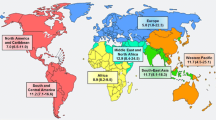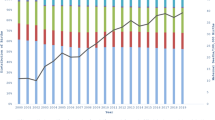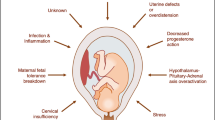Abstract
Objectives
To explore provincial variation in both excess and inadequate pre-pregnancy body mass index (BMI) and gestational weight gain (GWG) and their impact on small- and large-for-gestational-age (SGA, LGA) infants.
Methods
Four provinces with a perinatal database capturing the required exposures participated: British Columbia (BC), Ontario (ON), Nova Scotia (NS), and Newfoundland and Labrador (NL). In multiple, concurrent retrospective studies, we included women ≥ 19 years, who gave birth from 22+0 to 42+6 weeks’ gestation, to a live singleton from April 2013–March 2014. From adjusted odds ratios, we calculated population attributable fractions (PAF) of SGA and LGA for BMI and GWG.
Results
The proportion of overweight and obese women increased from western to eastern Canada. In BC, ON, NS, and NL, the proportions of women who were overweight were 21.1%, 24.0%, 23.7%, and 25.4%, while obesity proportions were 14.2%, 18.1%, 24.2%, and 29.8%, respectively. Excess GWG affected 53.9%, 49.9%, 57.6%, and 65.6% of women, respectively. Excess GWG contributed to 29.5–42.5% of LGA, compared with the PAFs for overweight (6.8–12.0%) and obesity (13.2–20.6%). Inadequate GWG’s contribution to SGA (4.8–12.3%) was higher than underweight BMI’s (2.9–6.2%).
Conclusion
In this interprovincial study, high and increasing proportions of women from west to east had excess pre-pregnancy BMI, and between half to two thirds had excess GWG. The contributions of GWG outside of recommendations to SGA and LGA were greater than that of low or high BMI. GWG is a potentially modifiable determinant of SGA and LGA across Canada.
Résumé
Objectifs
Explorer les écarts provinciaux dans l’indice de masse corporelle (IMC) élevé ou faible avant la grossesse et le gain de poids (GPG) excessif ou insuffisant durant la grossesse et leur effet sur la naissance de nourrissons petits ou gros pour l’âge gestationnel (PAG, GAG).
Méthode
Ont participé quatre provinces ayant des bases de données périnatales saisissant les données requises : la Colombie-Britannique (C.-B.), l’Ontario (Ont.), la Nouvelle-Écosse (N.-É.) et Terre-Neuve-et-Labrador (T.-N.-L.). Dans plusieurs études rétrospectives parallèles, nous avons inclus les femmes ≥19 ans ayant accouché entre la 22e + 0 et la 42e + 6 semaine de grossesse d’un enfant unique vivant entre avril 2013 et mars 2014. D’après les rapports de cotes ajustés, nous avons calculé les fractions attribuables dans la population (FAP) des nourrissons PAG et GAG selon l’IMC et le GPG.
Résultats
La proportion de femmes en surpoids et obèses augmente d’ouest en est au Canada. En C.-B., en Ont., en N.-É. et à T.-N.-L., les proportions de femmes en surpoids étaient de 21,1 %, 24 %, 23,7 % et 25,4 %, et les proportions de femmes obèses étaient de 14,2 %, 18,1 %, 24,2 % et 29,8 %, respectivement. Le GPG excessif a touché 53,9 %, 49,9 %, 57,6 % et 65,6 % des femmes, respectivement. Le GPG excessif a contribué à 29,5–42,5 % des nourrissons GAG, comparativement aux FAP pour le surpoids (6,8–12 %) et l’obésité (13,2–20,6 %). La contribution du GPG insuffisant aux nourrissons PAG (4,8–12,3 %) était supérieure à celle du faible IMC (2,9–6,2 %).
Conclusion
Dans cette étude interprovinciale, les proportions de femmes ayant un IMC élevé avant la grossesse étaient élevées et augmentaient d’ouest en est, et entre la moitié et les deux tiers des femmes ont eu un GPG excessif. La contribution d’un GPG hors de l’intervalle recommandé à la naissance de nourrissons PAG et GAG était supérieure à la contribution d’un IMC faible ou élevé. À l’échelle du Canada, le GPG est un déterminant potentiellement modifiable de la naissance de nourrissons PAG et GAG.
Similar content being viewed by others
References
Adegboye, A. R. A., & Heitmann, B. L. (2008). Accuracy and correlates of maternal recall of birthweight and gestational age. BJOG: An International Journal of Obstetrics & Gynaecology, 115(7), 886–893.
Bergmann, R. L., Richter, R., Bergmann, K. E., et al. (2003). Secular trends in neonatal macrosomia in Berlin: influences of potential determinants. Paediatric and Perinatal Epidemiology, 17(3), 244–249.
Bodnar, L. M., Siega-Riz, A. M., Simhan, H. N., et al. (2010). The impact of exposure misclassification on associations between prepregnancy BMI and adverse pregnancy outcomes. Obesity, 18(11), 2184–2190.
Callaway, L. K., Prins, J. B., Chang, A. M., et al. (2006). The prevalence and impact of overweight and obesity in an Australian obstetric population. The Medical Journal of Australia, 184(2), 56.
Cedergren, M. (2006). Effects of gestational weight gain and body mass index on obstetric outcome in Sweden. International Journal of Gynaecology and Obstetrics, 93(3), 269–274.
Davies, G. A., Maxwell, C., McLeod, L., et al. (2010). Obesity in pregnancy. International Journal of Gynecology & Obstetrics, 110(2), 167–173.
Djelantik, A. A., Kunst, A. E., van der Wal, M. F., et al. (2012). Contribution of overweight and obesity to the occurrence of adverse pregnancy outcomes in a multi-ethnic cohort: population attributive fractions for Amsterdam. BJOG, 119(3), 283–290.
Dzakpasu, S., Kaczorowski, J., Chalmers, B., et al. (2008). The Canadian maternity experiences survey: design and methods. Journal of Obstetrics and Gynaecology Canada, 30(3), 207–216.
Dzakpasu, S., Fahey, J., Kirby, R. S., et al. (2015). Contribution of prepregnancy body mass index and gestational weight gain to adverse neonatal outcomes: population attributable fractions for Canada. BMC Pregnancy & Childbirth, 15(21).
Dzakpasu, S., Duggan, J., Fahey, J., et al. (2016). Estimating bias in derived body mass index in the Maternity Experiences Survey. Health Promotion and Chronic Disease Prevention in Canada, 36(9), 185–193.
Gilboa, S. M., Correa, A., Botto, L. D., et al. (2010). Association between prepregnancy body mass index and congenital heart defects. American Journal of Obstetrics and Gynecology, 202(1), 51. e51–51. e10.
Health Canada. Prenatal nutrition guidelines for health professionals: gestational weight Gain Available: http://www.hc-sc.gc.ca/fn-an/nutrition/prenatal/ewba-mbsa-eng.php. Accessed 22 June 2010.
Health Canada, Expert Advisory Group on National Nutrition Pregnancy Guidelines. Prenatal nutrition guidelines for health professionals (catalogue # 978-1-100-16831-9) Available: http://publications.gc.ca/collections/collection_2011/sc-hc/H164-126-2010-eng.pdf. Accessed 15 Sep 2011.
Huber, L. R. B. (2007). Validity of self-reported height and weight in women of reproductive age. Maternal and Child Health Journal, 11(2), 137–144.
Institute of Medicine and National Research Council of the National Academies. (2009). Weight gain during pregnancy: reexamining the guidelines. Washington, DC: The National Academies Press.
Kim, S. Y., Sharma, A. J., Sappenfield, W., et al. (2014). Association of maternal body mass index, excessive weight gain, and gestational diabetes mellitus with large-for-gestational-age births. Obstetrics and Gynecology, 123(4), 737–744.
Kramer, M. S., Platt, R. W., Wen, S. W., et al. (2001). A new and improved population-based Canadian reference for birth weight for gestational age. Pediatrics, 108(2), E35.
Lowell, H., & Miller, D. C. (2010). Weight gain during pregnancy: adherence to Health Canada’s guidelines. Health Reports, 21(2), 31–36.
McDonald, S. D., Pullenayegum, E., Taylor, V., et al. (2011). Despite 2009 guidelines few women report being counseled correctly about weight gain during pregnancy. American Journal of Obstetrics and Gynecology, 205(4), 333.e331–333.e336 (Editor's Choice).
Nehring, I., Schmoll, S., Beyerlein, A., et al. (2011). Gestational weight gain and long-term postpartum weight retention: a meta-analysis. The American Journal of Clinical Nutrition, 94(5), 1225–1231.
Nohr, E. A., Vaeth, M., Baker, J. L., et al. (2008). Combined associations of prepregnancy body mass index and gestational weight gain with the outcome of pregnancy. The American Journal of Clinical Nutrition, 87(6), 1750–1759.
Ong, K. K., Ahmed, M. L., Emmett, P. M., et al. (2000). Association between postnatal catch-up growth and obesity in childhood: prospective cohort study. BMJ, 320(7240), 967–971.
Perinatal Services BC. Healthy weight during pregnancy Available: http://www.perinatalservicesbc.ca/health-professionals/professional-resources/health-promo/healthy-weight-during-pregnancy. Accessed 20 Feb 2017.
Reiss, K., Breckenkamp, J., Borde, T., et al. (2015). Contribution of overweight and obesity to adverse pregnancy outcomes among immigrant and non-immigrant women in Berlin, Germany. European Journal of Public Health, 25(5), 839–844.
Rooney, B. L., Schauberger, C. W., & Mathiason, M. A. (2005). Impact of perinatal weight change on long-term obesity and obesity-related illnesses. Obstetrics and Gynecology, 106(6), 1349–1356.
Ruckinger, S., von, K. R., & Toschke, A. M. (2009). An illustration of and programs estimating attributable fractions in large scale surveys considering multiple risk factors. BMC Medical Research Methodology, 9, 7.
Schellong, K., Schulz, S., Harder, T., et al. (2012). Birth weight and long-term overweight risk: systematic review and a meta-analysis including 643,902 persons from 66 studies and 26 countries globally. PLoS One, 7(10), e47776.
Schieve, L. A., Perry, G. S., Cogswell, M. E., et al. (1999). Validity of self-reported pregnancy delivery weight: an analysis of the 1988 National Maternal and Infant Health Survey. American Journal of Epidemiology, 150(9), 947–956.
Statistics Canada. 2011 National Household Survey: data tables|ethnic origin (264), single and multiple ethnic origin responses (3), generation status (4), age groups (10) and sex (3) for the population in private households of Canada, provinces, territories, census metropolitan areas and census agglomerations, 2011 National Household Survey. Available: http://www.12.statcan.gc.ca/nhs-enm/2011/dp-pd/dt-td/Rp-eng.cfm?TABID=1&LANG=E&A=R&APATH=3&DETAIL=0&DIM=0&FL=A&FREE=0&GC=12&GL=-1&GID=1118299&GK=1&GRP=0&O=D&PID=105396&PRID=0&PTYPE=105277&S=0&SHOWALL=0&SUB=0&Temporal=2013&THEME=95&VID=0&VNAMEE=&VNAMEF=&D1=0&D2=0&D3=0&D4=0&D5=0&D6=0. Accessed 11 Jul 2016.
Stotland, N. E., Cheng, Y. W., Hopkins, L. M., et al. (2006). Gestational weight gain and adverse neonatal outcome among term infants. Obstetrics and Gynecology, 108(3 Pt 1), 635–643.
Thorsdottir, I., Torfadottir, J. E., Birgisdottir, B. E., et al. (2002). Weight gain in women of normal weight before pregnancy: complications in pregnancy or delivery and birth outcome. Obstetrics and Gynecology, 99(5 Pt 1), 799–806.
Vanstone, M., Kandasamy, S., Giacomini, M., DeJean, D., & McDonald, S. D. (2016). Pregnant women's perceptions of gestational weight gain: a systematic review and meta-synthesis of qualitative research. Maternal & Child Nutrition, 21(1), 1–19.
Werler, M. M., Louik, C., Shapiro, S., et al. (1996). Prepregnant weight in relation to risk of neural tube defects. JAMA, 275(14), 1089–1092.
World Health Organization. (2000). Obesity: preventing and managing the global epidemic. Report of a World Health Organization consultation. Geneva: World Health Organization WHO Obesity Technical Report Series 894.
World Health Organization Expert Consultation. (2004). Appropriate body-mass index for Asian populations and its implications for policy and intervention strategies. Lancet, 363(9403), 157–163.
Yu, Z. B., Han, S. P., Zhu, G. Z., et al. (2011). Birth weight and subsequent risk of obesity: a systematic review and meta-analysis. Obesity Reviews, 12(7), 525–542.
Funding
Dr. Sarah D. McDonald is supported by a Canadian Institutes of Health Research Tier II Canada Research Chair in Maternal and Child Obesity Prevention and Intervention, Sponsor Award #950-229920. This financial support had no role in the design and conduct of the study; collection, management, analysis, and interpretation of the data; preparation, review, or approval of the manuscript; and the decision to submit the manuscript for publication. No external funding was secured for this study.
Author information
Authors and Affiliations
Corresponding author
Ethics declarations
Conflict of interest
None to declare.
Rights and permissions
About this article
Cite this article
McDonald, S.D., Woolcott, C., Chapinal, N. et al. Interprovincial variation in pre-pregnancy body mass index and gestational weight gain and their impact on neonatal birth weight with respect to small and large for gestational age. Can J Public Health 109, 527–538 (2018). https://doi.org/10.17269/s41997-018-0086-x
Received:
Accepted:
Published:
Issue Date:
DOI: https://doi.org/10.17269/s41997-018-0086-x




